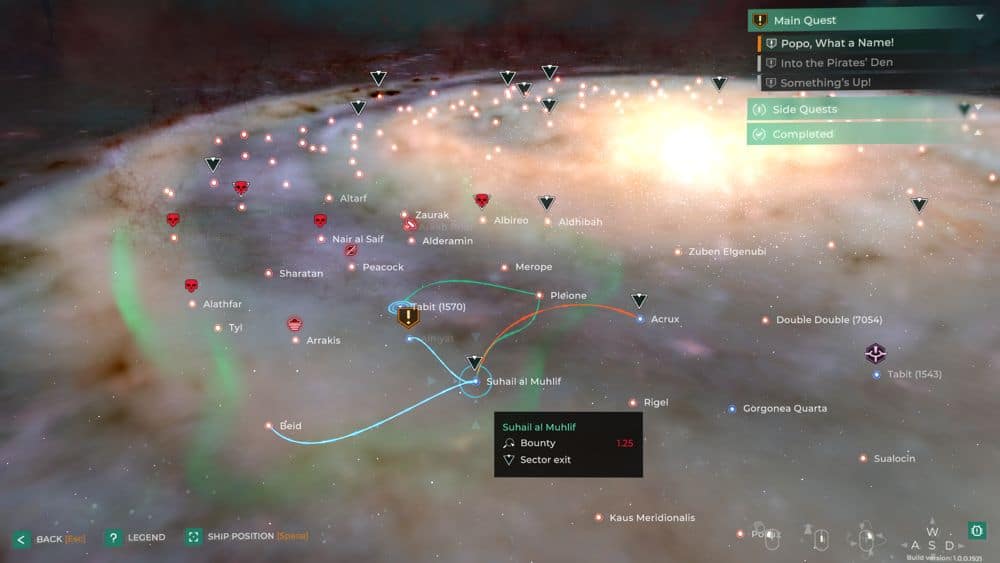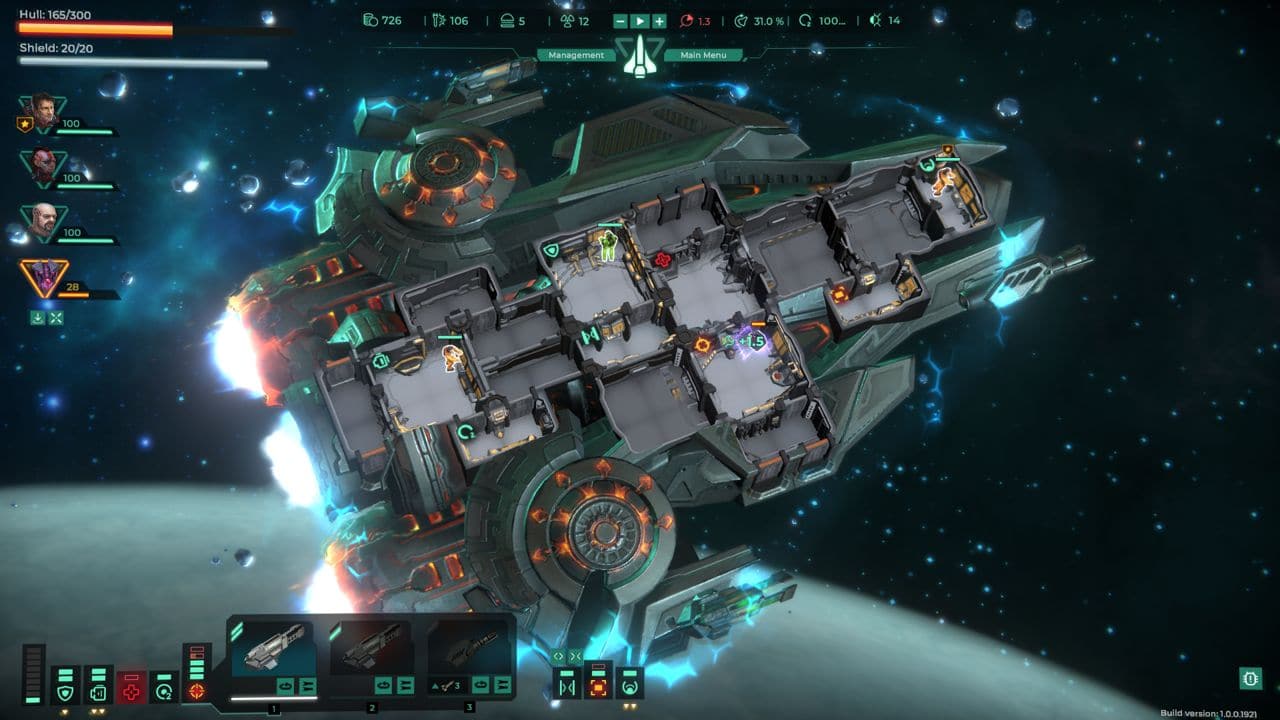Trigon: Space Story is one of those games that struggle to shut down: its all in all simple mechanics literally generate a whole universe of combinations and stories. In Trigon, mankind competes with three other races for control of the galaxy, and we, as the captain of a Federation ship, participate in this struggle. It is a formula that has already been seen, however, this game manages to dress again and make intriguing with great effect. So let’s see what Trigon: Space Story offers us again with this review.
The Trigon: Space Story review
As soon as we tried Trigon: Space Story to write this review, the memory immediately flew to another great indie classic, FTL: Faster Than Light. FTL, released in 2012, unfortunately looks ten years old even if it is the inventor of a formula that still works very well. We are in fact facing a fusion between a roguelike and a hardcore management software.
The setting is paradoxically simple: we are the captain of a starship engaged in an exploratory mission. The galaxy where we move is made up of a series of points connected to each other and the ship is able to jump between two adjacent points. At each arrival we will be faced with a situation to manage which, in many cases, will involve a firefight. The game becomes difficult when we are called to manage the ship’s resources such as energy, fuel, food, oxygen, weapons, personnel etc etc. Because our spaceship is a very delicate system that must be balanced from time to time as we grow it to face increasingly difficult missions.
When we play we have available a story modewith a series of missions to accomplish, e a free mode, where we can explore and conquer as we want. Also, the galaxy and events are procedurally generated, so every game and every mission will be uniquemaking the re-playability of this title very high.
A tried and tested idea, but very well thought out
Trigon takes the formula launched by FTL, makes it its own, and dresses it with dramatic elements giving us a compelling story to follow. While with FTL we simply had to get to the other side (and we often died trying) Trigon it offers us a story that forces us to chart a course and a series of events that push us along the way.
The mechanics have also changed: they have become more dynamic and captivating. In fact, the other element that clearly distinguishes Trigon from FTL is that the designers decided to make the game more forgiving. In FTL, in fact, defeat was always around the corner while Trigon allows for a simpler escape from conflicts and easier repairs of the ship’s structures. This does not mean that the game is easier, but it becomes less frustrating and we can follow the story. This choice, we must admit, we liked a lot.
What hasn’t changed, however, is the difficulty of managing resources to keep the ecosystem in balance inside the ship. A few new elements have been added, but the core, which is also the beating heart of the game, is still there.
The roguelike

The roguelike soul of trigon is immediately visible: we cannot take a step without ending up in a battle. Enemies are generated randomly, so it is not always guaranteed that they are within our reach, and escape becomes an option to consider.
The positions we move between are the pivot points generated to build the galaxy. Each point can be reached by all its neighbors, but the galaxy is divided into sectors. To access another sector it is necessary to use a portal which, like all self-respecting portals, has a guardian that we will have to defeat. The difficulty of the Guardian varies based on the resources available in the sector.
Some positions they are not open space but merchant stations; there you can sell and buy materials or recruit new crew members. These stations become immediately an important part of our strategy, because some of the spaceship’s resources (such as food and fuel) are consumed quickly. Therefore, you need to find the right compromise between the exploration and collection of materials and stay close to a supply point.
Another very important aspect from a strategic point of view is that, unlike many other roguelikes, moving costs fuel and fuel is always limited. This means that we will not be able to move as we please indefinitely, but we will have to plan our supplies well. Furthermore, even not moving has a cost, because the food supplies are continuously decreasing.
The management

The management part of the game is the one that, in absolute terms, we found the most interesting. There are not many resources, numerically speaking: money, metal, food and fuel. To these, however, we must add the most important resource of all: energy. Our generator, in fact, must support the modules that make up the spaceship. Each module has a feature, and in some cases it is necessary for the survival of the crew (for example the oxygen generator).
To upgrade our ship we will have to do upgrade of individual modules or add features paying money and metal. These new elements, however, they will require more energy to function and therefore we will also have to upgrade the generator, which in turn will require other resources. Same goes for the crew: increasing it means having more features and bonuses, but more oxygen and more food will be needed to keep it alive. To increase food and oxygen we will need more energy or, if we cannot afford it, to ration the current one. However, increasing the crew is necessary to use advanced spaceship modules.
All these dynamics trigger gods cycles of addictions with an unstable balance that we must be able to manage. Also because, before the resources in one quadrant run out, we must have a ship powerful enough to defeat the guardian and move on to the next quadrant.
The interactive battles
The game alternates on two phases: one strategic and one interactive. In the first we decide the route and the allocation of resources, while in the second we fight with an enemy ship.
The interactive part, beyond depending on a correct allocation of resources, is quite demanding. Indeed, we have to deal with two fronts at the same time. On the one hand, we have to select weapons and decide, at each turn, which modules to attack from the enemy ship. On the other hand, we must send our crew to repair enemy-damaged modules and fight off any invaders who have teleported aboard.
Honestly, we found it not an impossible difficulty but a little off the scale from the rest of the design. Fortunately, you can pause the game and study the situation to be able to decide exactly what to do.
The Trigon: Space Story review at a glance
Trigon: Space Story draws heavily on a great classic but renews its mechanics and inserts a respectable story that pushes us to explore the whole galaxy to discover its secret. The learning curve isn’t steep (the tutorial takes about 15 minutes), but the level of challenge can become substantial.
Trigon: Space Story is a title that we recommend with enthusiasm, especially if you are a lover of management. Don’t be discouraged if you’re not a sci-fi lover, because in the end it only serves to give context.
PRO
- Revisiting a formula that works well
- Great replay value
- Simple to learn
AGAINST
- Only one scenario for the story
- Interactive parts in stark contrast to the managerial ones













Leave a Reply
View Comments